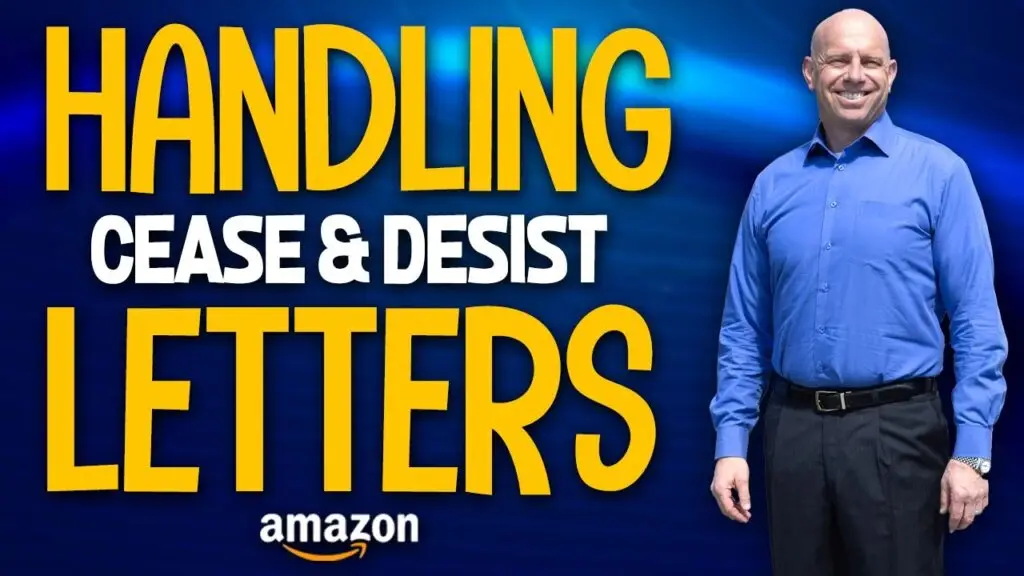Amazon Cease & Desist Letters - Protect Your IP Rights
We protect private label Amazon sellers and brands against hijackers & counterfeiters worldwide.

Cease & Desist Letters for Amazon Sellers:
As an Amazon seller, your brand is one of your most valuable assets. Unauthorized resellers, counterfeiters, and intellectual property (IP) infringers can damage your reputation, lower your profits, and create confusion in the marketplace. A well-crafted cease and desist letter is a powerful tool to protect your brand and enforce your rights.
At Amazon Sellers Lawyer, we focus on drafting and enforcing cease and desist letters tailored to Amazon’s ecosystem. Whether you’re dealing with unauthorized sellers, counterfeit products, or trademark infringement, our legal team is here to help you take swift action and maintain control over your listings.

What Is an Amazon Cease and Desist Letter?
A cease and desist letter is a formal legal notice demanding that an individual or business stop engaging in activities that violate your intellectual property rights. If left unchecked, unauthorized sellers and counterfeiters can severely impact your business by:
- Selling counterfeit or low-quality versions of your products
- Damaging your brand’s reputation through inferior customer experiences
- Undercutting your pricing and reducing profitability
- Violating your trademark, copyright, or patent protections
Our Process To Protect Sellers
By sending a cease and desist letter, you officially notify the infringing party of their unlawful activities and give them an opportunity to voluntarily stop before more aggressive legal actions are taken. Our Approach to Cease and Desist Letters:
1 Identifying Infringers and Unauthorized Sellers:
Before sending a cease and desist letter, we conduct a thorough analysis to confirm that the seller is infringing upon your rights. This includes examining:
Seller information and account details
Product listings and potential counterfeit indicators
Trademark and copyright violations
MAP (Minimum Advertised Price) policy violations
2 Drafting a Strong, Legally Sound Cease and Desist Letter:
Our experienced team drafts customized cease and desist letters that clearly outline:
The specific infringement or unauthorized sale
A demand to remove the infringing listings immediately
Legal consequences of non-compliance, including possible litigation
A response deadline for compliance
3 Delivering the Cease and Desist Letter:
Depending on the situation, we send cease and desist letters through multiple channels to maximize effectiveness, including:
Amazon’s Buyer-Seller Messaging system
The seller’s registered business email or physical address
Legal representatives of the infringing party
4 Following Up & Enforcing Compliance:
If the unauthorized seller or counterfeiter fails to comply, we escalate the situation by:
Filing complaints with Amazon’s Brand Registry & Report Infringement tools
Issuing Digital Millennium Copyright Act (DMCA) takedown requests
Pursuing legal action for continued violations
More Info On Cease and Desist
For more information on Cease and Desist, be sure to check out our blogs. We break down everything you need to know, from legal insights to real-world examples—read now!

Types of Amazon Account Suspensions We've Resolved
We handle a wide range of Amazon suspensions, working to reinstate your account as quickly and smoothly as possible. Our approach has helped many sellers resolve issues and continue their business without disruption.

2 kinds of Amazon listing hijackers:
Unauthorized Resellers & Counterfeiters
All vendors will have a harder time fighting unauthorized resellers than they will fighting counterfeiters. Why? Because Amazon doesn’t take part in manufacturer/vendor/reseller agreements except for newly gated brands. Amazon’s entire focus is on what shows up on customers’ doorsteps.
If there are counterfeiters (sellers using your pictures or verbiage), a lawyer can tell you if the hijackers are violating your intellectual property rights and whether you should seek to have them removed by Amazon’s complaint system, using cease and desist letters, or a DMCA take down.
Why Choose Amazon Sellers Lawyer?
- Experiences Team: Our attorneys focus on Amazon seller account reinstatements.
- Proven Success Rate: Thousands of sellers have regained their accounts with our help.
- Fast & Effective Appeals: Time is money—we work quickly to resolve your suspension.

